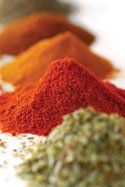Flavor and Weight Loss
High-impact seasonings can make people feel fuller, possibly leading to weight loss, according to a new study.

Can a food’s taste lead to a trim waist? Perhaps, according to the results of a new study presented in San Francisco in June at the annual meeting of the Endrocrine Society (Chevy Chase, MD).
In the six-month study, which was organized by the Smell & Taste Treatment and Research Foundation (Chicago), 2436 overweight or obese volunteers received a variety of savory or sweet flavor crystals to apply to their food. A control group of 100 subjects did not receive the crystals, also known as tastants. The treatment group had an average weight and body mass index (BMI) of 208 lb and 34, respectively, at baseline.
The volunteers, who only knew that the flavors were salty or sweet, sprinkled cheddar cheese, onion, horseradish, ranch, taco, or parmesan tastants on salty foods, and cocoa, spearmint, banana, strawberry, raspberry and malt tastants on sweet foods.
By the end of the study, the treatment group had lost an average of 30.5 lb and 15% of their body weight, compared with only 2 lb in the control group. In addition, the BMI of the treatment group dropped by an average of 5 points, compared with an average loss of just 0.3 in the control group.
According to Alan Hirsch, MD, the study’s lead investigator, there are several potential explanations for why the tastants led to weight loss. First, the flavor crystals could have induced feelings of satiety in the control group, making them eat less overall. Second, the tastants enhanced the flavor of bland foods like vegetables, prompting a shift to better dietary choices.
Brazilian Flavors Market Approaches $200 Million
Led by consumer thirst for exotic tastes such as acai, demand for Brazilian flavors hit $197.5 million in 2006 and could reach $283.7 million by 2013, according to a report by Frost & Sullivan (Palo Alto, CA).
Industry consolidation and low market growth are putting pressure on Brazilian flavor prices, however, notes the report.
“The main challenge faced by manufacturers is the exact imitation of natural flavors and expanding their application across a wide spectrum of product categories,” according to Taly Nahmias, a research analyst for Frost & Sullivan’s food and beverage ingredients group.
Future product introductions in applications such as yogurts, ice cream, and flavored water are likely to propel the industry further, the report says. Recent product launches have included fruit-based milk drinks, milkshakes, juices, cereals, desserts, and petit-suisse cheeses.
“End-users are increasingly demanding ready-to-eat foods that are tasty and nutritious, and have easy-to-cook options in order to accomplish their daily diet and be more productive,” according to Nahmias. “Flavors are one of the main additives that impart taste and hence, are essential to a food product’s success.”
For more information about the report, contact Frost & Sullivan by calling 877/463-7678 or visiting www.frost.com.
The study seemed to have a high dropout rate, with 2436 volunteers entering the study and only 1436 completing it six months later. However, Hirsch notes that some of the volunteers exited the study early after achieving their ideal body weight.
Despite the study’s promising results, Hirsch, who is also the founder of the Smell & Taste Treatment and Research Foundation (Chicago), cautions that the tastants may not work for everyone.
“It could be that the percent of weight reduction would be lower in people who are less obese,” Hirsch says. “In theory, tastants won’t work for people who eat even when they’re full and for people who have lost their sense of smell.”
The impact of GLP-1 on supplements, functional foods, and retail: a webinar from CRN
January 29th 2025The recent CRN webinar discussed GLP-1 medications' impact on supplements, functional foods, and retail, covering consumer trends, global market insights, retailer strategies, industry implications, and future opportunities for innovation.

.png&w=3840&q=75)

.png&w=3840&q=75)



.png&w=3840&q=75)



.png&w=3840&q=75)




